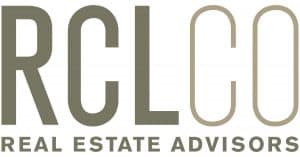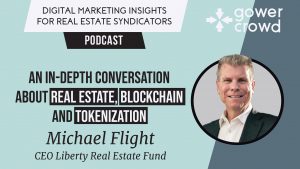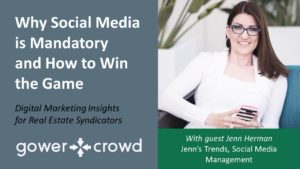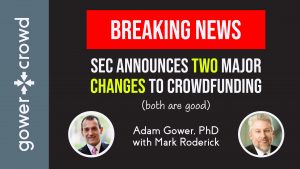Joshua A. Boren, RCLCO
GlobeSt: Top Commercial Real Estate Marketing Influencer
 Joshua A. Boren, Director of Business Development & Marketing Strategy, RCLCO
Joshua A. Boren, Director of Business Development & Marketing Strategy, RCLCO
I'm thrilled to introduce you to one of the highest energy digital marketing guys I've come across for a long while, Josh Boren of RCLCO who recently won prestigious recognition, as one of the country's top real estate marketing influencers by GlobeSt.
Josh is a powerhouse of digital marketing insights and knowledge. Becoming recognized as an influencer in the commercial real estate industry is entirely within your reach and in this episode, you're going to hear lots of ideas for how to do exactly that.
What You're Going to Learn
- How to Generate Real Estate Investor Leads Online
- The 6-10 Touchpoints You Need Online to Connect with Investors
- How to Use Your Digital Presence to Build Relationships
- How to Sell a Football Stadium on Twitter
- And much more!
Listen To or Watch the Full Podcast Here
Show Highlights
How to Generate Real Estate Investor Leads Online
Adam: Lead generation. So tell...let me ask a straight question. So you've been now at it for four years. What has been the most successful effective method for lead generation, think about a whole gamut, right? From your Web sites all the way through to social media sites, email marketing. Just like what has been the most effective method?
Josh: You know, it's funny, they these things all kind of work together, right. And for part of our business, we're a service oriented business. We provide real estate consulting services. We don't invest our own capital. We are a third party objective perspective to developers, sponsors, other commercial real estate industry professionals that seek outside guidance. And so for us, you know, it's about getting in front of the right people and also making sure that we're there when they need us. And I think that timing piece is really critical. We're not selling widgets where I know, you know, it's been 90 days and they're down to their last one and I should give them a call. So it's about it's about general exposure and multiple touchpoints. I like to say in the sales and business development side, you typically need about six to 10 touchpoints before you really bring in that business with somebody. And those touchpoints can be as simple as ensuring somebody is getting a newsletter from you or ensuring that the presentations that your consultants recently took on it at a conference are our mass blast or shared with them. And so a lot of these things play in together. One big thing we did was was significantly grow our database in terms of the folks that we made sure we're actually engaging with us and then fine getting our marketing outbound material.
That was a big piece such as actually onboarding Salesforce or a CRM platform. We can come back to that in a little bit. But with those sort of tools, I think the one thing we found most interesting and unique is we we provide a lot of thought leadership in terms of real estate presentations. And we recently, upon revamping the Web site, making it more accessible. We recently added sort of a data capture to understand or gather information on who is actually downloading these specific reports. And that's been really unique from a lead generation perspective, because somebody is taking time not just to spend on our Web site or through our social channels, but then go and search for something in particular that's of interest to them and then are willing to put in their name, their email, their company and title or whatever it may be to actually then download that report. That's been unique. And we've been able to then follow up very specifically with those individuals understanding what their interests are as opposed to it being a bit more cold.
The 6-10 Touchpoints You Need Online to Connect with Investors
Adam: But let's talk about touchpoints, because this is very important. So what we do is create a massive volume of content that we roll out on all social media channels plus e-mails for anybody that signs up. When you... And I've heard this term six to ten touch points before... Something happens. Not really sure what that is? You're selling dates. We're raising capital, so we're but we're not...neither of us is selling widgets. It's it's a long sales process. But what are those six to ten touch points? What actually are they? Those 6-10 touchpoints. What actually are they? And how do they figure into that...I use the term investor journey about the customer journey to getting to know you.
Josh: Yeah. I think regardless it's the routing. What however those touchpoints kind of begin. You're ultimately trying to tell a story or craft a narrative around who you are as an organization and maybe even more importantly around who the personalities are within your organization. I think people are sort of the lifeline to these firms being great. I mean, part of the reason our RCLCO is such a historic and sort of legacy type firm that has a great reputation is we've been around, yes, 50 plus years, but a lot of our senior leadership has been around for a significant amount of that time and their opinions are valued. And that's also why a group like ourselves so, so interesting is the next generation of potential clients come in and their habits are slightly differen, those six to 10 touchpoints might look different as well. So I still think at the end of the day in digital marketing and marketing in general is a huge piece of this, but nothing replaces the face to face conversation. And ultimately, whether it's via zoom info or zoom meaning I should say, or whatever that may be. And zoom info is another tool that we use as an example. We can talk later, but that is a face to face or a touch point interaction. Now, a lot of those first, you know, first impressions, I'll say happen online now. And as much as you love for them to be in person all the time, you have to recognize that your brand and these people have an online persona and reputation as well.
And I know you've sent share some things earlier about what I should think about. And that's one thing I think you can always take away, is whatever lives online is going to be there forever and you have to keep that in mind. So for us, it's about crafting that story across a six to 10 touchpoints. And we do in a way that is both sort of mass focused because we only have so much bandwidth. So that could be our general newsletter. It could be one of those six touch points a year. Let's say here's what we've been working on. Here's something you might find interesting. Let us know if this sounds relevant. We can follow up, but it also can be far more customized. So we may have within, you know, our larger database, and we do, a number of highly segmented and targeted database lists that then are provided specific sort of thought leadership or interesting research that we think would be most applicable to them. And that's sort of crafting that story that's a bit more unique to them directly. So the sports team owner who's building a new arena but is hoping to put a large mixed use development adjacent to that, is going to get a potentially different marketing strategy in terms of the content, then maybe the, you know, master plan developer who is seeking to build 15000 houses on, you know, couple thousand acres in the desert going forward. And our approach is going to be, first, we want to make sure you see what we can do in terms of our thought leadership.
And so that exposure. Things like webinars in particular have been another interesting tool for us where not just an article, but folks can hear us talk about it and get deep into discussion. But really, what we want to be able to do is customize our approach, our response and our outreach to whatever it may be that's most interesting to that specific client. And I think that's something that maybe we do a little bit differently. In particular, I've always focused on more on the sales side maybe than marketing, but I think it's about listening more so than talking initially. And that first meeting or that first opportunity I have with somebody, I want to hear everything that's that's kind of their pain points are important to them are the things keeping them up at night. And then I'll come back with unique marketing collateral, a unique approach, a unique pitch and how that all forms together from a strategy within our group that actually fits what they need. I mean, our firm offers so many services iftried to go in and, you know, mass sell everything, everybody, I'd drown them in confusion. And so it's really about first listening and then setting up those six to 10 kind of follow up points, a mix of both in-person hopefully phone and then specifically heavily on digital marketing to kind of keep that relationship alive and keep yourself top of mind for when the time is ready.
FOR REAL ESTATE DEVELOPERS
THE WHITE BOARD WORKSHOP
Learn the exact system best of class sponsors use to raise money online.
How to Use Your Digital Presence to Build Relationships
Adam: How do you encourage those newcomers with only 40, 50 years in the business to become comfortable expressing that personality online so that they can establish a relationship before somebody ever even meets them?
Josh: Absolutely. And it's so funny you brought that up because you mentioned it a few minutes ago and I wanted to come back to then. I guess it ties back into the original conversation. But a lot of times you can use that digital presence to sort of create that familiarity before you even meet somebody. I am very active on Twitter in particular. I read it way too many times a day. I'm probably addicted, but I gather information more interestingly, not only disseminate our information. I also use it as a connection tool. And so there's a handful, in particular of commercial real estate professionals, that I find to be very informative that all engage with. And I've never met any of these individuals and they're from all over the country. And yet I already feel like I know them. And I would bet that they would come back and tell me the same thing. And I found that very early on in my my career. I would you know, before this role, I was doing business development for an architectural firm and a very specialized niche. And I would go to conferences, and this is kind of early in the days of Twitter, you know, maybe 2010 when it was sort of first rolling out. And I had established myself at that time as sort of a go to connection or news source within that sector for somebody you could could kind of connect the dots and provide information.
And I would walk into conferences and I'd go to get my name back to some of you, like you're at Joshua Boren. And I'm like, and you're. And they'd give me their Twitter handle. And I'd say, oh, my God. I mean, your avatar is not your avatar. You have a little, you know, cartoon normally. But like, we know each other and we've been talking for years now and there's that sort of sense of connection. So for me, it's a little bit easier if somebody who's on the front line doing business development and marketing to kind of focus my time there. It is tricky. And I don't think there's less buy in from some of those. You call them newbies. I'll call are "more senior folks." They certainly want to do it. And some of them, to be honest, are very active. We have one or two guys that are the best in our firm, in particular at LinkedIn. And I think part of it is platform driven as well. Right. They're also maybe a little bit more engaged on Facebook, whereas I would say our newer staff hires tend to be more engaged on Twitter and LinkedIn for work or Instagram and LinkedIn for work. Right. So there's that kind of segmentation as well. And we're starting to better now that we have more bandwidth, we're starting to better define different strategies through those different mediums as well.
So Twitter might look different than what LinkedIn looks like. And a lot of it what we've been discussing is about building and exposing those personalities to folks. Right. So on Twitter, where maybe we can start getting senior leadership to add one or two comments to an article or something they see which gives insight into their, you know, knowledge, LinkedIn might be a place where they can really open up and provide more deep, in-depth analysis around how they're thinking and, you know, maybe some insight. And by the way, I was just in Costa Rica on a personal trip and we went to this resort and the residential was selling for X. Right. Whatever that may be. So there's not that there's a lack of buy in. Honestly, our biggest struggle right now, which is a good thing, is too much work. So, you know, the the end of the cycle is still booming. Things are still going well. And so to carve out that time from senior leadership to say, hey, start thinking about the pipeline and building this up going forward, because at some point we want to make sure we're countercyclical to whatever is happening or what does happen when the market shifts. You know, it's sort of that eb and flow of well, we're really busy right now also.
So we've we're now putting those protocols in place to get ahead of things a little bit. And I think that there's an appreciation around that. But I think also, as you know, either we bring more resources on, hire, more folks can or if work slows down slightly, there's going to be a larger emphasis from our senior team and everybody on spending more time on social, encouraging more of that personality to come out. And a lot of what they do already is about doing that at conferences and events and things like that. I mentioned earlier, you know, for us lead generation and thought leadership are kind of the really important things. Sponsorship for us having our name on something doesn't really mean a lot. It's more about, to your point, that attendee list that being able to get in front of a group and speak to them at a conference. Leading a roundtable. Leading a webinar. Those are the things that where we feel like we can show our value as a firm and our our staff sort of insights and knowledge, which is really where they're adding value that open things up for us. And so that's really where our emphasis has been and where we're continuing to drive, and I think it speaks to your point. It's about making sure that they can get their personalities out there through these mediums.
How to Sell a Football Stadium on Twitter
Adam: So the story of how you sold a football stadium on Twitter, please.
Josh: Yes, my previous job in business development for a sports and stadium architect, a couple different firms and the biggest kind of win of my career was, was securing the design for the new A.S. Roma Stadium in Rome, Italy, and doing so via Twitter to all. I had certainly chased and prospected with the Americans who took over the team in 2010 or whenever that was ultimately the only way I actually got a hold of them was through Twitter. And again, it was very early in the process and the Twitter days, I actually connected with the chairman's executive assistant and asked her to add have him add me on his Twitter account. He then direct messaged me about a week later after I continually was posting some stadium development news. And it was one of those messages as a great to where it was. Hey, check out these pics. Dot, dot, dot, dot, dot. Another another chairman who got spammed. Right. He said, no seriously, if you see this direct message, call this number, please. And within four hours, he was in L.A. I had him in our office and that started the whole thing. So the large, large projects happened through Twitter as well.
Related to this episode:















